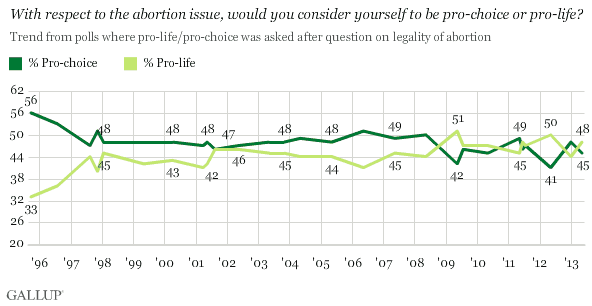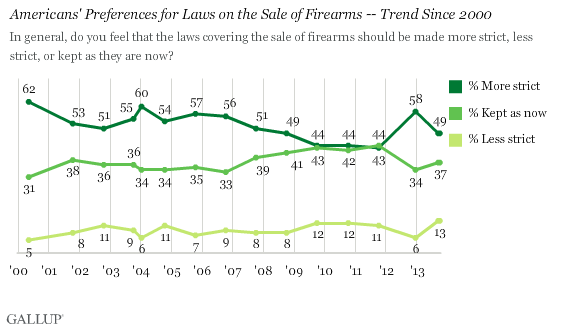Gov. Andrew Cuomo (D-NY), scion of the New York political family, has declared that conservative extremists have no place in his state. What is it that makes them extreme? Apparently, it is opposition to abortion, gay marriage, and gun control.
Today, January 22, 2014, is the 41st anniversary of Roe v. Wade, the Supreme Court decision that overturned state laws that prohibited abortion throughout most of the pregnancy. If we look at polling on abortion, what portion of Americans are simply not welcome in New York?
The first figure shows that since 1998 or so, at least according to Gallup, a stable split between Americans who think of themselves as either pro-choice or pro-life. While the terms “pro-choice” and “pro-life” can mean many things, and do not necessarily dictate where one stands on the legality of abortion or the goodness of Roe, roughly half of Americans call themselves pro-life.
In the next figure, we see that most Americans believe some legal restrictions are needed for the procedure (72% when we add the “illegal in all circumstances” to the “legal only under certain circumstances), and 20% believe it should be illegal in all circumstances.
Here, in this figure from a 2013 Pew survey, 43% of Americans view abortion as morally wrong, and 46% see it as morally acceptable. There is a split, naturally, about how that morality should be applied to Roe.
When we look at the Second Amendment, we see similar things. Again, according to Gallup, 50% of Americans favor either less strict gun laws, or no change to the existing laws.
In recent decisions, the U.S. Supreme Court struck down Washington, D.C.’s ban on handguns, as well as its requirement that all guns be kept disassembled and with trigger locks (District of Columbia v. Heller), as well as Chicago’s ban on unregistered firearms and its requirement for annual re-registration (McDonald v. City of Chicago). In both cases, the Court ruled the laws conflicted with the Second Amendment. Though the Court did not rely on public opinion to make its rulings, a heavy majority of Americans are against a ban on handgun possession, continuing a trend that began in the late 1960s, at least according to Gallup’s data.
Finally, there is the issue of gay marriage or gay rights. Here, the trend seems to be running against the more traditional position. Again, using Gallup’s data, Americans are growing more accepting and tolerant of gay rights in general and gay marriage in particular. We have witnessed a stunning reversal in how American’s perceive the validity of homosexual marriages. Though once a minority belief (27% in 1996), support for gay marriage now commands a majority (54%). The Supreme Court, again, seems to be in step with the public. In 2012, the Court struck down a federal law that defined marriage as between a man and a woman (U.S. v. Windsor), though the issue of whether or not states can restrict their own definitions of marriage is still in dispute (see Hollingsworth v. Perry).
Again, polls are blunt instruments, especially ones that are published without statistical controls in place. Regardless of that caveat, it seems that Cuomo’s conceptions are not rooted in reality. If anything, his views, that large chunks of people who disagree strongly with him are not welcome in New York, are extremist and intolerant. Like too many executives, Cuomo is not interested in persuasion or statesmanship; he does not seek to serve the people of New York, but to rule them. Instead of engaging his opponents, he hopes to squelch them and run them out of his fiefdom.






 Bert Wheeler
Bert Wheeler
 Jeff Haymond
Jeff Haymond
 Marc Clauson
Marc Clauson
 Mark Caleb Smith
Mark Caleb Smith
 Tom Mach
Tom Mach